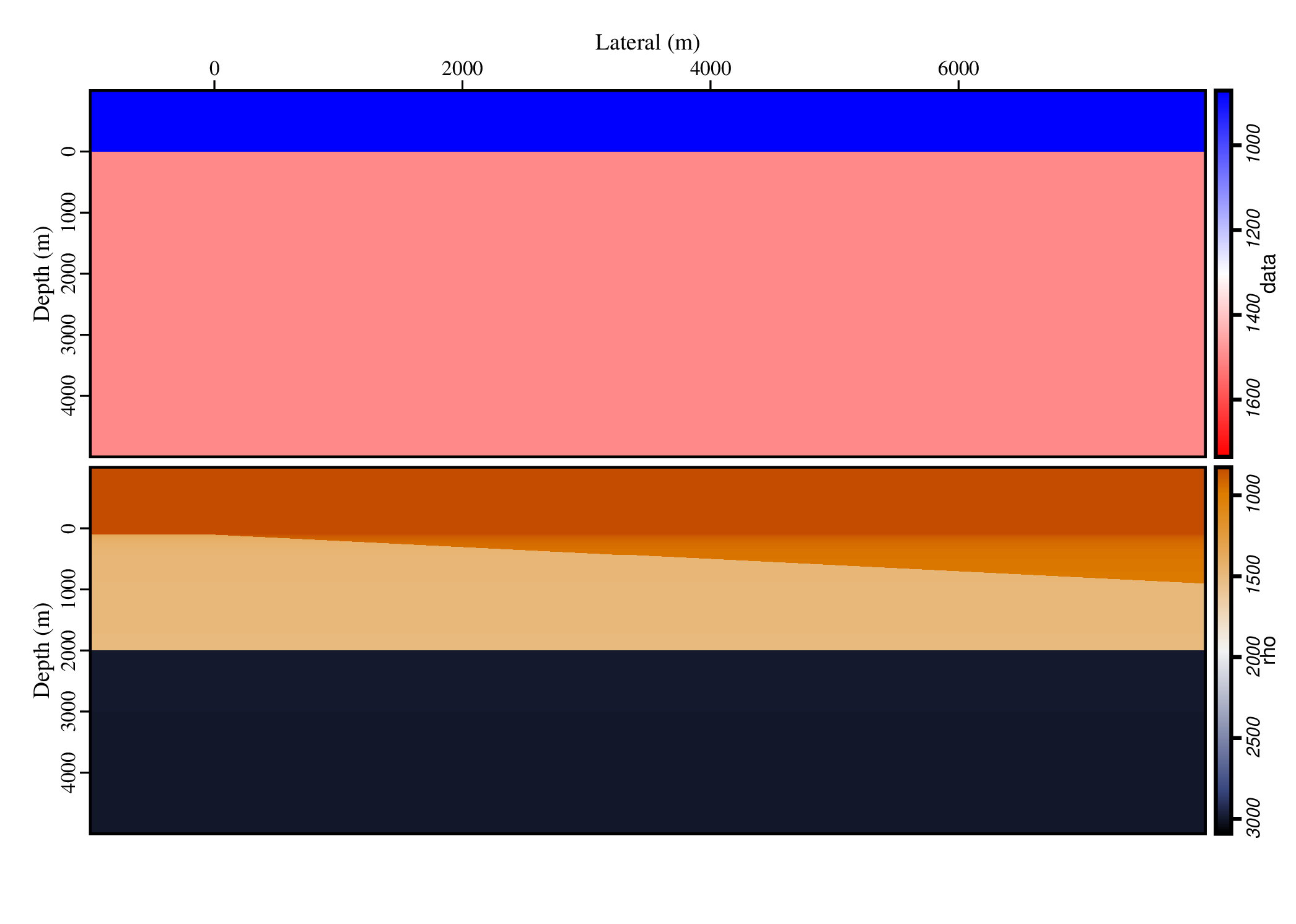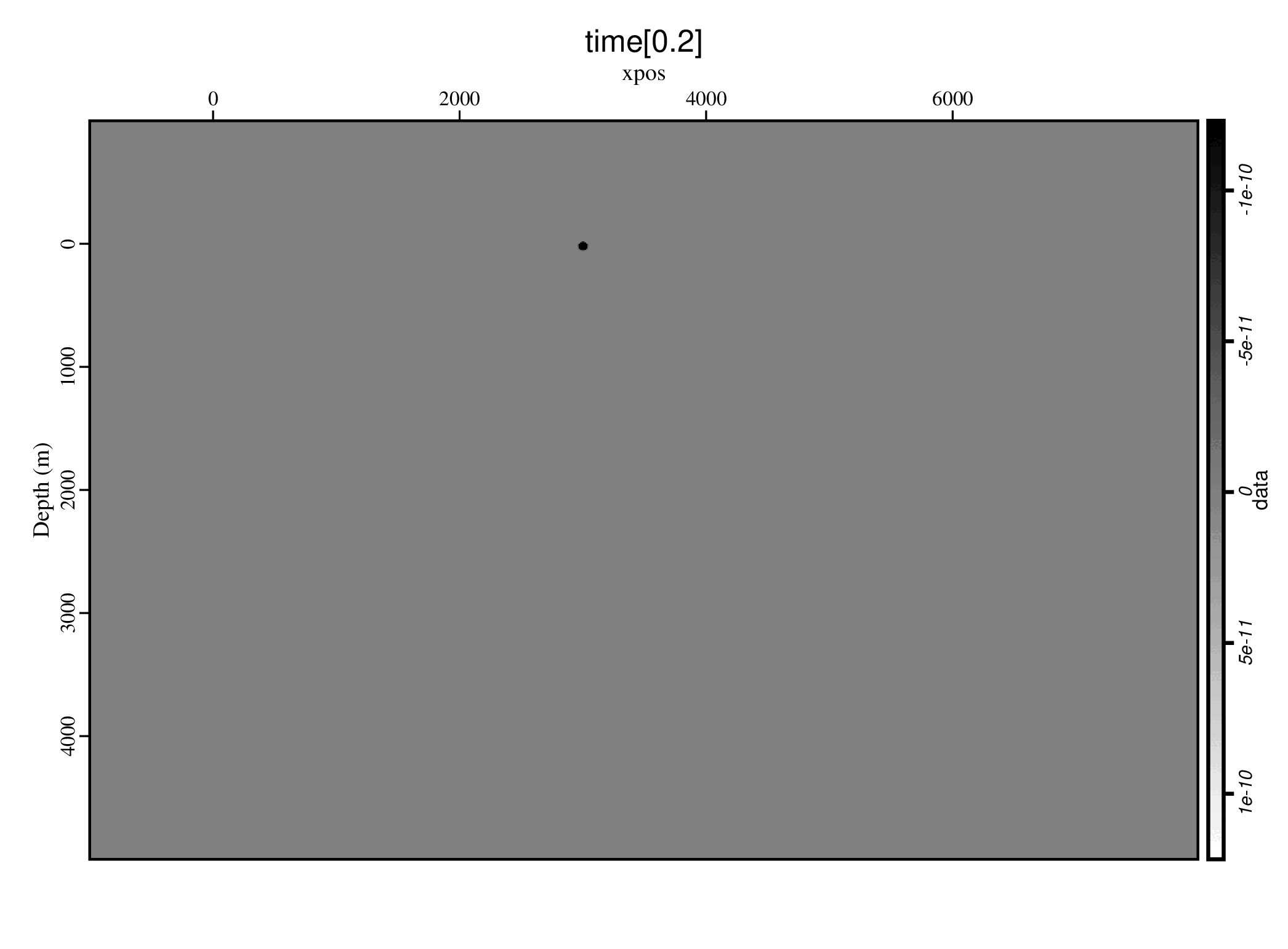- We create a velocity model and a density model, and store them as two vectors data and rho in the file data/vel.sg. The two models sampled in 10 meters in both lateral and depth directions. The model has a dipping water bottom and a flat subsurface reflector.
- We create a source of Ricker wavelet with peak frequency 30Hz. The source is planning to be fired at 3000m in lateral position and 10 meter deep in the water.
- Now we create two observation geometries: a hydrophone streamer on the water surface, and a geophone array on the water bottom, and store them as two columns in a single dataset data/rr.sg.
- At last, we do the finite difference wavefield modelling. It has three inputs: the source, the velocity model, and the observation geometry. All of them are stored in the same format, supported by the sigclear-soig.
from experiment import *
Process('vel', None,
'''
sgcreate data.s0=-1000 data.ds=10 data.ns=600 nx=900
| sgfieldmath lateral:f="-1000+jx*10"
ref1:f="100+(lateral>0)*0.1*lateral" ref2:f="2000"
| sgfieldmath rho:F="1.225+998*(atan(data.time/50)/PI+0.5)"
data="340+1160*(data.time>=0)"
| sgfieldmath rho="rho+500*(data.time>=ref1)+1500*(data.time>=ref2)"
| sgattribute index=lateral
dx:f=10 nx:i=900 ox:f=-1000 ny:i=1
''')
Figure('./vel.png',
'''
sgplotps top.label="Lateral (m)" data.image=bwr rho.image=owb
''')

Process('source',None,
'''
sgcreate data.ns=2000 data.ds=0.002 data.s0=-0.3
| sgfieldmath index.rename=fldr sz:f=10 sx:f="3000"
gy:f=0 sy:f=0 data="ricker(30*data.time)"
''')
Figure('./source.png', 'sggraphps ')

Process('rr', None,
'''
sgcreate data.ns=300 data.ds=10 data.s0=2000 nx=2
| sgfieldmath index.rename=rl
gx:F=data.time gz:F="(jx==0)*10+jx*(100+data.time*0.1)"
| sgwindow remove=data
''')
Figure('ss', 'source',
'''
sgfieldout fields=sz,sx
| sggraphps yreverse=y x=sx y=sz
sz.style="*" sz.color="FF0000"
xmin=-1000 xmax=7990 ymin=-1000 ymax=4990
''')
Figure('rr', 'rr',
'''
sgresamp dt=200
| sgfieldmath color:i="jx"
| sggraphps yreverse=y x=gx y=gz
gz.style=. gz.color=color
xmin=-1000 xmax=7990 ymin=-1000 ymax=4990
''')
Figure('./obs.png', 'vel ss.ps rr.ps',
'''
sgplotps --default=rho rho.top.label="Lateral (m)"
rho.image=bwr rho.image.bar=right
| sgoverlayps ${SOURCES[1:]}
''')

Process('data wfd', 'source vel rr',
'''
sgwefd we=awe2 vel=${SOURCES[1]} vel.vp=data
out.grid=${SOURCES[2]} out.grid.vects=gz,gx
wfd=${TARGETS[1]}
''')
Figure('./data.png',
'sgplotps data.image=seismic multicol=subgroup')

Figure('./wfd.gif',
'''
sgwindow time.min=-0.001 time.max=3.2
| sgplotps out.title="@group"
''')

